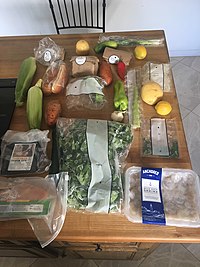
Photo from wikipedia
Abstract This work shares a model that was developed to compare the energy requirements of meal-kit delivery systems to conventional grocery shopping. Meal-kit services can reduce food waste because the… Click to show full abstract
Abstract This work shares a model that was developed to compare the energy requirements of meal-kit delivery systems to conventional grocery shopping. Meal-kit services can reduce food waste because the kits pre-portion ingredients for each recipe, thereby saving energy. However, the supply chain and packaging requirements of meal-kit delivery are different than those for grocery stores, potentially offsetting any energetic benefits of reduced food waste. If meal-kit delivery replaces some trips to the grocery store, then transportation-related savings might be significant. The tradeoffs of these competing effects are non-obvious, so mass and energy balances were used to assess embedded energy in both pathways. The model was illustrated under representative operating conditions for a consumer in Austin, Texas using Monte Carlo simulation. Both per-meal and per-week, a meal-kit delivery service meal is more energy intensive than procuring the same meal from conventional grocery stores primarily due to single-use packaging. Consumer transportation to the grocery store was also found to be particularly energy intensive. These results suggest that the energetic requirements of meal-kit delivery services could be reduced such that they are less than conventional grocery shopping if reusable or low-impact packaging is used, and if the delivery services are able to reduce the number of weekly trips to the grocery store. 1
Journal Title: Journal of Cleaner Production
Year Published: 2019
Link to full text (if available)
Share on Social Media: Sign Up to like & get
recommendations!